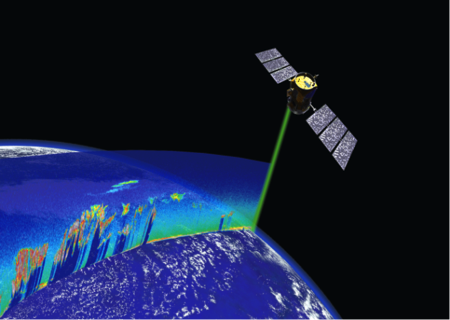CALIPSO - CALIPSO
CALIPSO Mission

The Cloud-Aerosol Lidar and Infrared Pathfinder Satellite Observations (CALIPSO) satellite uses lidar and imaging systems to detect aerosols and thin clouds that are invisible to radar observations. The global 3D perspective CALIPSO provides helps scientists learn about the height, amount and type of aerosols and clouds. Launched in 2006, the satellite still provides researchers with information to better understand the atmosphere, help improve forecasts and make predictions about changing climates.
CALIPSO is a joint venture between NASA (the United States of America's space agency) and CNES (the French space agency).
CALIPSO is a joint venture between NASA (the United States of America's space agency) and CNES (the French space agency).
Understanding Climate Through Clouds and Aerosols
Clouds consistently cover over 60 percent of the Earth’s surface. Some cloud types block sunlight from our planet and create a cooling effect, while other cloud types have a warming effect by preventing infrared radiation from leaving Earth. Today, scientists know that clouds and aerosols, or airborne particles, play critical roles in regulating Earth’s climate. In order to accurately predict the future course of the global climate, scientists must understand the composition of clouds and how they are influenced by aerosols.
CALIPSO is a historically significant satellite and has outlived the projections of its life expectancy, continuing to gather important information about clouds and aerosols. Along with CloudSat, it is the first satellite to actively take long-term measurements of clouds and aerosols.
To measure clouds and aerosols, CALIPSO uses Lidar to send pulses of energy towards Earth’s surface. Lidar is similar to radar but uses light as a medium instead of microwave energy. These pulses bounce off particles in the atmosphere and help determine the properties and distance to these particles. This technique helps scientists observe the vertical profiles of clouds and create visualizations of what is floating in the atmosphere.
CALIPSO is a historically significant satellite and has outlived the projections of its life expectancy, continuing to gather important information about clouds and aerosols. Along with CloudSat, it is the first satellite to actively take long-term measurements of clouds and aerosols.
To measure clouds and aerosols, CALIPSO uses Lidar to send pulses of energy towards Earth’s surface. Lidar is similar to radar but uses light as a medium instead of microwave energy. These pulses bounce off particles in the atmosphere and help determine the properties and distance to these particles. This technique helps scientists observe the vertical profiles of clouds and create visualizations of what is floating in the atmosphere.
CALIPSO and GLOBE
CALIPSO monitors clouds and aerosols, two Atmosphere Protocols in GLOBE. By participating in CALIPSO activities, GLOBE students can learn how NASA is advancing Earth science. The CALIPSO mission's outreach efforts are aimed at providing educational opportunities for teachers, K-12, undergraduates, graduate students and the general public.
The mission's outreach activities support "students as scientists" by providing educator professional development, student-scientist mentoring, curriculum resource development and public outreach through collaborative mission efforts.
The mission's outreach activities support "students as scientists" by providing educator professional development, student-scientist mentoring, curriculum resource development and public outreach through collaborative mission efforts.

Contact
GLOBE Master Trainer
NASA Langley Research Center, Science Directorate
100 NASA Road
Mail Stop 475
Hampton, VA 23681-2199
Telephone: (757) 864-6358
Fax: (757) 864-2671
MyPage
Email: jessica.e.taylor@nasa.go
NASA Langley Research Center, Science Directorate
100 NASA Road
Mail Stop 475
Hampton, VA 23681-2199
Telephone: (757) 864-6358
Fax: (757) 864-2671
MyPage
Email: jessica.e.taylor@nasa.go
France Country Coordinator
Centre National d'Etudes Spatiales (CNES)
Service Culture Spatiale
Communication externe Education et affaires publiques
18 Avenue Edouard Belin
31401 Toulouse cedex 9
France
Telephone: (33) 5 61 27 46 84
Fax: (33) 5 61 28 27 67
Skype: nadista25
MyPage
Email: Danielle.Destaerke@cnes.fr
Centre National d'Etudes Spatiales (CNES)
Service Culture Spatiale
Communication externe Education et affaires publiques
18 Avenue Edouard Belin
31401 Toulouse cedex 9
France
Telephone: (33) 5 61 27 46 84
Fax: (33) 5 61 28 27 67
Skype: nadista25
MyPage
Email: Danielle.Destaerke@cnes.fr





